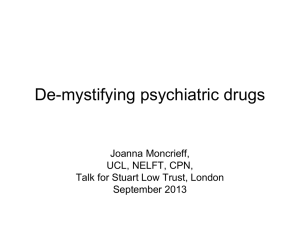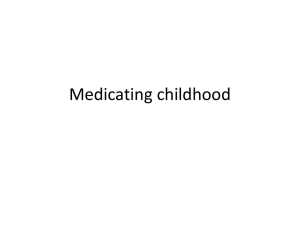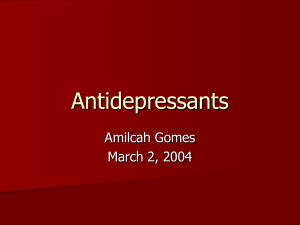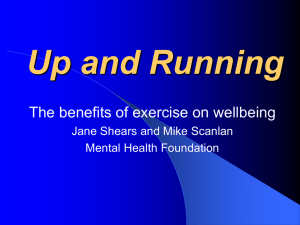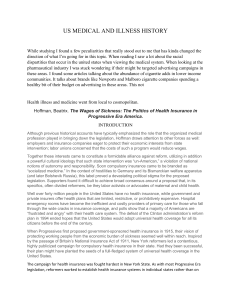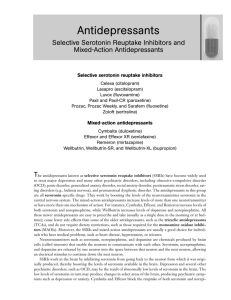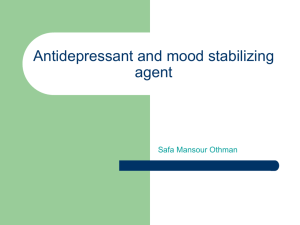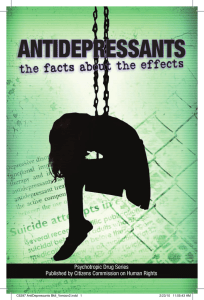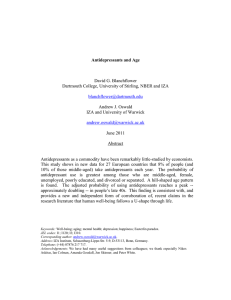Psychiatric Drugs
advertisement
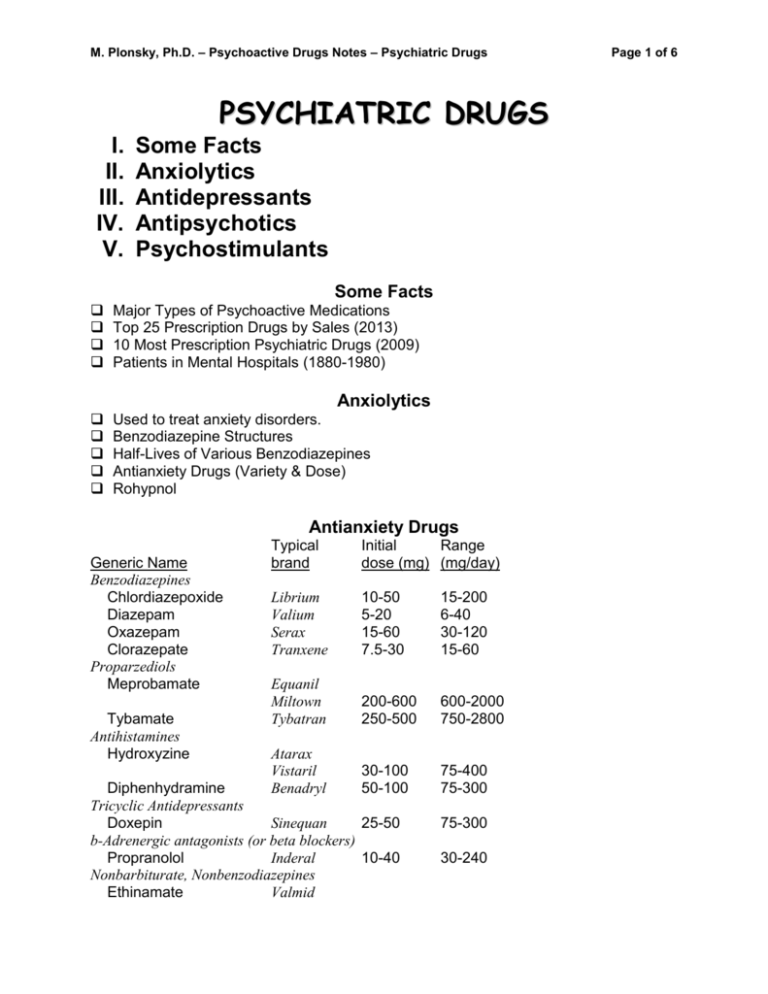
M. Plonsky, Ph.D. – Psychoactive Drugs Notes – Psychiatric Drugs PSYCHIATRIC DRUGS I. II. III. IV. V. Some Facts Anxiolytics Antidepressants Antipsychotics Psychostimulants Some Facts Major Types of Psychoactive Medications Top 25 Prescription Drugs by Sales (2013) 10 Most Prescription Psychiatric Drugs (2009) Patients in Mental Hospitals (1880-1980) Used to treat anxiety disorders. Benzodiazepine Structures Half-Lives of Various Benzodiazepines Antianxiety Drugs (Variety & Dose) Rohypnol Anxiolytics Antianxiety Drugs Generic Name Benzodiazepines Chlordiazepoxide Diazepam Oxazepam Clorazepate Proparzediols Meprobamate Tybamate Antihistamines Hydroxyzine Typical brand Initial Range dose (mg) (mg/day) Librium Valium Serax Tranxene 10-50 5-20 15-60 7.5-30 15-200 6-40 30-120 15-60 Equanil Miltown Tybatran 200-600 250-500 600-2000 750-2800 Atarax Vistaril Benadryl 30-100 50-100 75-400 75-300 Diphenhydramine Tricyclic Antidepressants Doxepin Sinequan 25-50 b-Adrenergic antagonists (or beta blockers) Propranolol Inderal 10-40 Nonbarbiturate, Nonbenzodiazepines Ethinamate Valmid 75-300 30-240 Page 1 of 6 M. Plonsky, Ph.D. – Psychoactive Drugs Notes – Psychiatric Drugs Buspirone Page 2 of 6 BuSpar Rohypnol Or flunitrazepam is a benzodiazepine not legally available in the U.S. but prescribed in other countries for insomnia & anesthesia. Produces amnesia, muscle relaxation, & slowing of psychomotor performance. Sedation occurs 20-30 mins after administration of a 2mg tablet & lasts 8 hrs. Also, it is synergistic with alcohol. It is another of the “date rape” drugs. Antidepressants MAO lnhibitors Tricyclics SSRI's Atypical Popularity Bipolar Disorder Depression Treatment (Olfson, 02) (CDC, 11) Effectiveness (Kirsch, 09) MAO lnhibitors Exs. Parnate (Tranylcypromine), Marplan (Isocarboxazid), & Nardil (Phenelzine), etc. Inhibits enzyme that breaks down monoamines (DA, NE, 5HT). In addition to fatigue, dizziness & constipation, they can cause deadly surges in BP if taken with certain foods. Absolute Restriction - Aged cheeses; aged & cured meats; banana peel; broad bean pods; improperly stored meat, poultry, & fish; Marmite; sauerkraut; soy sauce & other soybean condiments; tap beer. Moderate Restriction - Red or white wine; bottled or canned beer (including nonalcoholic varieties). Tricyclics Increase DA, NE, & 5HT. Narrow margins of safety & effectiveness. Common side effects include grogginess, headache, constipation & weight gain. Examples: Imipramine Tofranil, Antipress Amitriptyline Amitril, Elavil Desipramine Norpramine Nortriptyline Aventyl, Pamelor Doxepin Sinequan Protriptyline Vivactil Amoxapine Asendin Trimipramine Surmontil M. Plonsky, Ph.D. – Psychoactive Drugs Notes – Psychiatric Drugs Page 3 of 6 SSRI's Specific Serotonin Reuptake Inhibitors. Enhance the effect of 5-HT by blocking its reabsorption. Typically take ≈1-4 weeks to have an effect. Exs. Prozac (fluoxetine), Zoloft (sertraline), Paxil (paroxetine), Celexa (citalopram), Lexipro (escitalopram), etc. Safer than the older antidepressants & easier to tolerate. Can cause nausea, diarrhea & decreased sexual function. Prozac Effectiveness - Greenburg, 94 Prozac Effectiveness - Greenburg, 94 A meta-analysis of 13 studies of the Prozac finds that it is no more effective than the older generation of antidepressants it has largely swept from the marketplace. Concludes that “fluoxetine produces modest effects, roughly comparable in magnitude to those of other antidepressants.” The average patient treated with fluoxetine had more improvement than 2/3’s of those who received a placebo. But meta-analysis of tricyclic antidepressants, which were widely used before the advent of Prozac, found equivalent or higher rates of effectiveness. Atypical Desyrel (Trazodone) Newest drugs - SNRIs Exs. Effexor (venlafaxine), Wellbutrin (bupropion), Pristique (desvenlafaxine), etc. Enhance both 5HT & NE. Side effects similar to SSRIs. With the broader effect, these drugs may help some depressed patients who don't respond to the simpler SSRI's. Wellbutrin is called Zyban when used to treat nicotine addiction. Augmentation Augmentation pharmacotherapy refers to the addition of drugs that are not standard antidepressants in order to enhance the effect of the antidepressant. In their review of the literature, Carvalho et al. (2007) concluded that, "Although augmentation strategies have been tested with various pharmacological agents, there are few controlled studies published." Ex: Seroquel (quetiapine), Abilify (aripiprazole) Abilify A partial dopamine agonist & atypical antipsychotic with additional antidepressant properties that is used in the treatment of schizophrenia, bipolar disorder, & clinical depression. It received FDA approval for use as an adjunct for major depressive disorder in 2007. M. Plonsky, Ph.D. – Psychoactive Drugs Notes – Psychiatric Drugs Page 4 of 6 Bipolar Disorder Person's mood swings from depression to excessive excitement. May show some or all of the following symptoms: Aggressiveness, elation, fast urgent talking, frantic physical activity, grandiose, unrealistic ideas & little need for sleep. Eskalith (Lithium) - is a common treatment. Maintenance therapy diminishes intensity of subsequent episodes. Effective within 1-3 weeks. Dose needs to be gauged carefully. Treatment - Olfson ’02 Compared data from 34,459 people who participated in a 1987 medical expenditures survey (USDHHS) to data from 32,636 from a similar 1997 survey (Agency for Healthcare Research & Quality). Folks treated for depression rose from 1.7 mil to 6.3 mil from 1987-1997 & proportion receiving antidepressants doubled. Patients who used antidepressants climbed from 37% to nearly 75%. At the same time, proportion receiving psychotherapy declined from 71% to 60%. Attributed increase to 3 factors: 1. Easing of the stigma attached to the disease. 2. Aggressively marketed new drugs (e.g., Prozac) (with less side effects) has helped make patients more willing to seek treatment. This included direct marketing to consumers and public-awareness campaigns about depression. 3. The Rise in managed care has also contributed to the increase in use of medication, which may be less costly and time-consuming than psychotherapy. Managed care also has placed more emphasis on primary-care physicians, who may be more likely to prescribe medication than to refer patients to specialists for psychotherapy. Treatment – CDC, 11 Use of antidepressant drugs has soared nearly 400% since 1988, making the medication the most frequently prescription used by people ages 18-44. 11% of Americans ages 12+ took antidepressants during the 2005-08 study period. In 1988, a year after FDA approved Prozac, 2.5 mil prescriptions were dispensed for it. By 2002, that number had risen to 33.5 mil. By 2008, antidepressants were the third-most-common prescription drug taken in America. <1/3 of folks taking 1 antidepressant & <1/2 of those taking multiple antidepressants have seen a mental-health professional in the past year. Antipsychotics Phenothiazines History Mechanism of Action Motor Side Effects Other Side Effects M. Plonsky, Ph.D. – Psychoactive Drugs Notes – Psychiatric Drugs Page 5 of 6 Representative Antipsychotics History In the 1950's a drug called chlorpromazine (CPZ, thorazine) came to be used for the treatment of schizophrenia. Prior to these drugs, violent patients were physically restrained or heavily sedated (among other procedures). In particular, thought disturbances, hallucinations, & delusions tend to subside with continued administration of the drug. Mechanism of Action Simply put, it is unknown. There are lots of hypothesis. Issue is complicated by the widespread & diverse effects of this class of drugs. For ex., they block NE, DA, ACh, 5-HT, & histamine receptor sites & also have extensive actions on endocrine function. The most promising theories involve transmission of info at the DA synapses. Motor Side Effects Parkinsonian Symptoms Difficulty in initiating voluntary movements, muscular rigidity, stooped posture, & tremors. More likely in older patients. Tardive Dyskinesia Involuntary movements of the mouth, as well as writhing movements of the hands, trunk, etc. Usually only occurs after chronic treatment & may get worse after withdrawal. Some symptoms are permanent. Akathisia A compulsive restlessness or desire to move, along with abnormal muscle sensations. More likely in younger patients. Etc. Other Side Effects Photosensitivity Skin may show rashes (an allergic reaction to light) or acquire patches of a blue-gray metallic discoloration. The eyes are even more of a problem. Orthostatic hypotension At first the patient may get dizzy when standing up. Results from interference with the bodies circulatory system. Miscellaneous Dry mouth, dilated pupils, weight gain, various hormonal abnormalities. Additional allergic reactions (relatively rare) include liver & blood problems. Representative Antipsychotics Phenothiazines Chlorpromazine Prochlorperazine Trifluoperazine Thorazine Compazine Stelazine M. Plonsky, Ph.D. – Psychoactive Drugs Notes – Psychiatric Drugs Fluphenazine Thioridazine Non-Phenothiazines Haloperidol Thiothixene Loxapine Clozapine Prolixin Mellaril Haldol Navane Loxitane Clozaril Page 6 of 6
